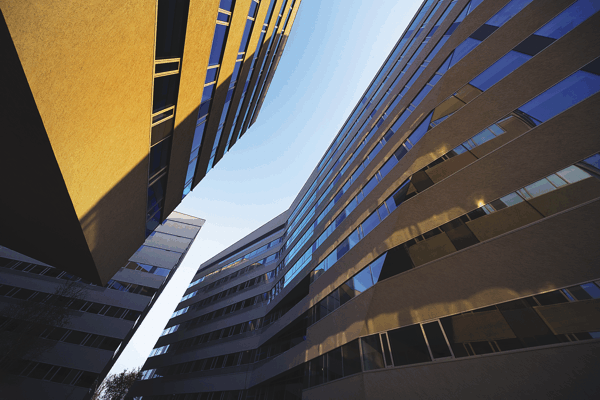Design and Realization
Népliget Center Office Block, Budapest
Architects: Richárd Hőnich, Ferenc Cságoly, Levente Szabó, Bálint Marosi, Ágota Józsa, Rita Terbe
Text: Győző Bujdosó
Photos: Tamás Bujnovszky
There is a new office block towering on Könyves Kálmán Boulevard, between the bus terminal in Népliget and the railway flyover of M5 motorway. The identity of this area is undergoing a radical change right now, with surviving old constituents and a series of new office blocks and retail houses appearing precariously so far. Népliget Center Office Block sits on its site as if it had been there for ages. Powerful and expressionist forms have been born, resulting in a structure with highly characteristic stylization. On the one hand it appears as a group of natural components such as cliffs, as the structures of the surface associate a kind of geological evolution. However, the design may be derived from strongholds, resembling a bastion, as it is defined by circular masonry with broken obtuse-angled planes. Masses with roofing look like houses from a certain angle, we can see gabled butts, and from the eastern side it even evokes the silhouette of a large antique tympanon.
Blocks of seven to nine storeys – broken and slit at several points – surround an irregular polygonal cortile. Walking here from the boulevard from the north, we can see a block of slanting planes tilted outward on the right towering above us, whilst on the left the path to the entrance goes underneath a block with a slanting lower plane supported by a robust block pillar. The inner garden is a kind of quasi-groove, with a picturesque terrain, abstract waterfalls and strong plank panelling. From this garden visitors coming here on foot have access to the reception areas of the three wings as well as the vertical chore of communication. Outside the elevators, on the facade towards the cortile the band of parapet walls separates from the roofing: they border vertical light shafts which we can see directly through the glazed elevator door or if we look out from behind one of the balustrade. These „light wells” are tiny but playful components counteracting the otherwise weighty dynamics of the complex: because of the recessed glazing on the lower storeys behind the bands of parapets we can see pierced and perforated sculpturesque structures, and as a result it is quite pleasant to sit down and relax here in this peculiar cortile resembling a deep valley basin. Anyway, it is only a first impression that the exterior is an unfriendly one. Surfaces keep alternating according to their geometrical structuring, and the shifts are high-standard ones, exploiting the extras of the produces applied here: on the lower plane of the parapet wall and above the glazing a sharp lintel profile casts a remarkable reflected strip of shadow on the glazing, emphasizing the floating impression of parapet strips. However, this material is far from being immaterial: the grey surface of plasterwork is textured in a slanting direction with rubbed marks. The glazing of the windows is made up of openable and fixed panes, completed by glass parapet with the same tones of grey as those of the plasterwork and the openings, as well as by glass strips lit by night changing their colours from block to block. Somewhat warmer, this shade of grey resembling the colour of doves was also part of an expressedly creative intention. According to the designer’s concept, the building is capable of entirely dissolving and immaterializing against the skies as its background on cloudy, greyish and gloomy days.
Leading architects: Hőnich Richárd DLA, Cságoly Ferenc DLA – Építész Stúdió Kft.
Co-architects: Szabó Levente DLA, Marosi Bálint DLA, Józsa Ágota, Terbe Rita – Hetedik Műterem Kft.
Fellow architects: Simon Orsolya, Almer Orsolya, Tánczos Tibor
Environment: Dr. Balogh Péter István, Gyüre Borbála – S73 Kft.
Static: Gonda Ferenc, Horváth Csaba – Dékettő Statikus Iroda Kft.
Installation: Dr. Morlin András, Cser Ildikó, Cseh Tamás – Axima-Suez Kft.
Electrical engineering: Kovács György, Ivanics Zoltán; Barna Gábor – Provill Kft.; Kód Kft.
Structure: Becker Gábor DLA, Varga Edit, Kapovits Géza, Esztergályos Viktor, Kuntner Ferenc – ADECO Kft.
Acoustics: Józsa Gusztáv – Józsa és Társai Kft.
Glass reception: Fekete Zsuzsanna
Painting: Halmi-Horváth István
Main contractor: Narva Kft.








